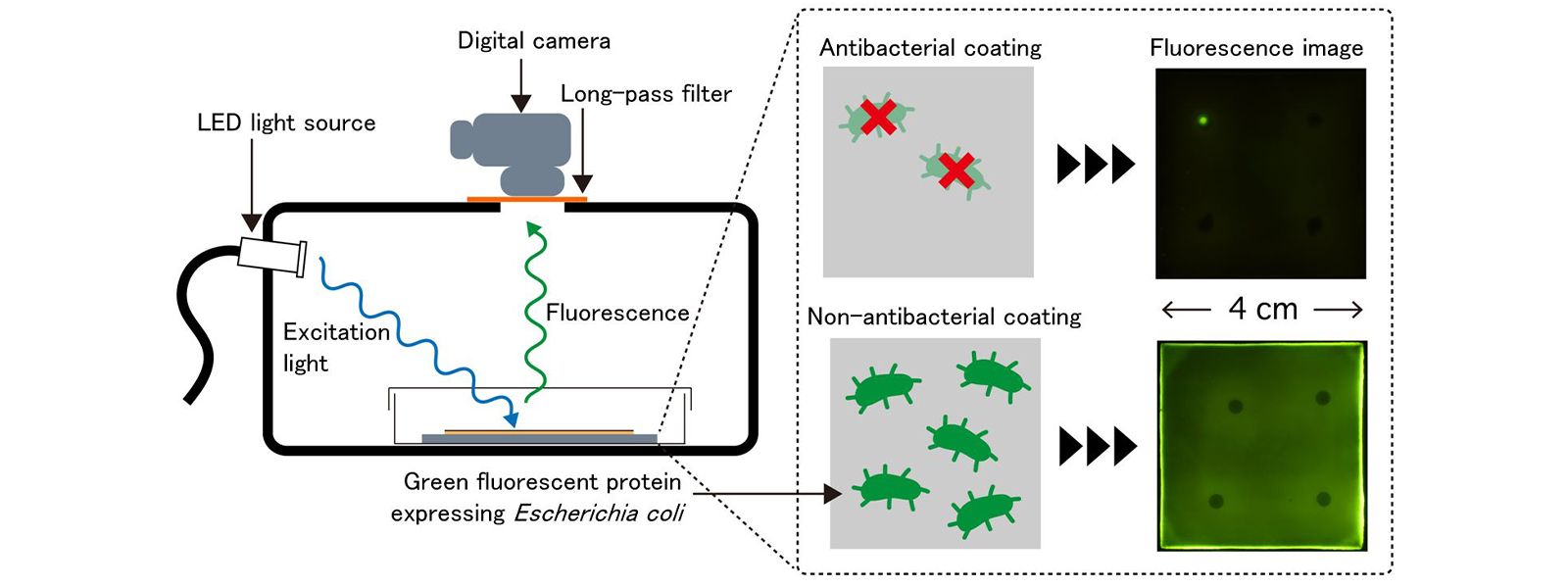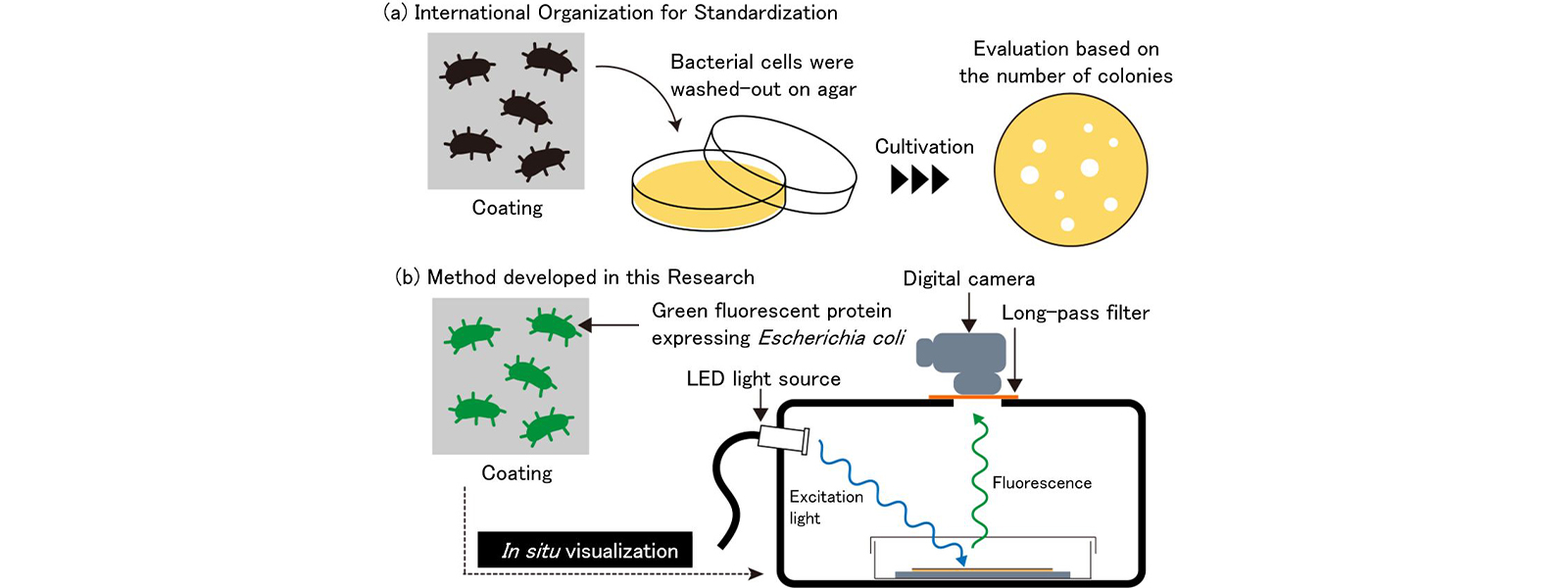- Research and Development
- 2025.02.03
Innovating an Evaluation System to Visualize the Antibacterial Effects of Coatings

February 3, 2025
Nippon Paint Holdings Co., Ltd.
Innovating an Evaluation System to Visualize
the Antibacterial Effects of Coatings
―Expecting contribution to the development of materials
for preventing nosocomial and other infections―
Key Highlights
- Achieved real-time visualization and evaluation of antibacterial effects by monitoring bacterial proliferation on coating surfaces.
- Enabled continuous data acquisition on the spatial distribution of bacteria on coating surfaces, surpassing the limitations of conventional methods outlined by International Organization for Standardization (ISO) standards.
- Provided precise performance evaluations of antibacterial coatings, paving the way for enhanced infection prevention efforts.

Overview
A research team led by Researcher Haruhiro Miyamae from Nippon Paint Co., Ltd., in collaboration with Assistant Professor Noriko Nakamura and Associate Professor Seiichi Ohta of the University of Tokyo's Graduate School of Engineering, has successfully developed a real-time evaluation system to visualize the antibacterial effects of coatings.
In this study, the research team successfully achieved continuous observation of bacterial proliferation on coating surfaces spanning several square centimeters. This was accomplished using E. coli expressing green fluorescent protein (Note 1) and a fluorescence observation device. This approach allows for the analysis of time-dependent changes in the spatial distribution of bacteria on coatings, which could not be assessed using conventional methods prescribed by ISO standards (Note 2). Fluorescence images captured during the study were converted into multiple quantitative indices, enabling systematic evaluation of factors such as coating size and culture medium volume. These analyses optimized the evaluation conditions. Under these optimized conditions, the antibacterial effects of coatings developed specifically for infection prevention (Note 3) were successfully demonstrated. This advancement enables more accurate evaluations of various antibacterial coatings, fostering their broader adoption. It is anticipated to play a significant role in enhancing infection prevention efforts in the future.
These research findings are scheduled to be published in the online edition of the British scientific journal Scientific Reports on January 31, 2025 (UK time).
Announcement Details
Research Background
The use of antibacterial and antiviral coatings on frequently touched surfaces, such as those in medical facilities and public transportation systems, has been proven effective in preventing the spread of infectious diseases, including COVID-19. Traditionally, the performance of antibacterial coatings has been assessed using methods specified by ISO standards. These methods involve washing bacteria that have proliferated on the coating into a culture medium, followed by re-culturing them on agar plates for evaluation. However, this approach does not allow for the acquisition of spatial distribution data or real-time information about bacterial activity on the coating (Figure 1a).
Furthermore, previous studies have shown that various factors, such as the density of bacteria applied to the coating, can significantly influence evaluation results. However, systematic examinations to optimize these factors have been insufficient, leaving evaluation conditions suboptimal. Consequently, there has been a pressing need for a new evaluation system that not only provides more accurate assessments of antibacterial coating performance but also visually demonstrates their effectiveness to consumers, thereby promoting their broader adoption.

(a) Conventional method as prescribed by ISO standards (b) Method developed in this research
Details of the Research
The research team successfully visualized the real-time spatial distribution of bacteria proliferating on coatings by utilizing E. coli expressing green fluorescent protein. This was achieved through images captured with a fluorescence observation device combining an LED light source, optical filter, and digital camera (Figure 1b). In contrast, traditional fluorescence microscopy methods were limited to evaluating the spatial distribution of bacteria on very small areas, measuring only a few square micrometers. Additionally, these methods were restricted to transparent coatings that allowed the excitation light to pass through. Using a custom-built observation device, the research team successfully obtained continuous spatial distribution data of bacteria over larger areas, spanning several square centimeters, even on opaque coatings. Fluorescence images captured during the process were transformed into quantitative indices, including the average brightness of fluorescent proteins, the brightness distribution along a line through the center of the coating, and the variability in brightness across the entire coating. These indices were used to systematically analyze the effects of factors such as coating size and culture medium volume on evaluation results. With optimized observation conditions, the team achieved real-time visualization of significant bacterial proliferation inhibition on antibacterial coatings. These coatings, previously evaluated under ISO standards, were shown to exhibit strong antibacterial effects, further confirming their performance (Figure 2).

(b) Fluorescence observation images showing E. coli expressing green fluorescent protein proliferating on a coating without antibacterial agents;
(c) Time-dependent changes in average brightness on each coating, as determined through image analysis
This method can be widely applied to other bacterial species expressing fluorescent proteins, paving the way for practical evaluations using pathogenic bacteria in the future. By employing this approach, it will be possible to more accurately assess the performance of various antibacterial coatings and visualize their effects in real time. This is expected to drive the widespread adoption of these products, ultimately contributing to enhanced infection prevention efforts. This research project was carried out as part of the collaborative efforts within the social collaboration program, “Creation of Innovative Coating Technologies.” This program was established through an industry-academia co-creation agreement between the University of Tokyo and Nippon Paint Holdings and is scheduled to run for five years, from October 1, 2020, to September 30, 2025.
The Details of Research Paper
| Magazine name | Scientific Reports |
|---|---|
| Title | Systematic study on the evaluation method of surface antibacterial activity based on the fluorescent observation of bacterial growth |
| Authors | Noriko Nakamura, Tatsuki Yamagishi, Wataru Nagata, Yuki Akahane, Hyemin Seo, Ayaka Otsuka, Daiki Hishikawa, Risa Yoshimoto, Nobuhiro Miyamae, Seiichi Ohta* |
| DOI | 10.1038/s41598-024-81945-3 |
| URL | https://doi.org/10.1038/s41598-024-81945-3 |
Glossary of Terms
(Note 1) Green Fluorescent Protein (GFP)
A naturally occurring protein that emits green fluorescence when exposed to ultraviolet or blue light. GFP can be readily introduced into cells and organisms, making it an invaluable tool in biotechnology and imaging applications.(Note 2) International Organization for Standardization (ISO)
The ISO is an independent, non-governmental international organization that develops and publishes standards to ensure quality, safety, efficiency, and interoperability across various industries, including technology, manufacturing, healthcare, and environmental management. Established in 1947, it is headquartered in Geneva, Switzerland.(Note 3) Antibacterial Coating
This research utilized “PROTECTON® Interior Wall VK-500,” a commercially available antiviral and antibacterial paint designed for indoor walls, produced by Nippon Paint Co., Ltd.


